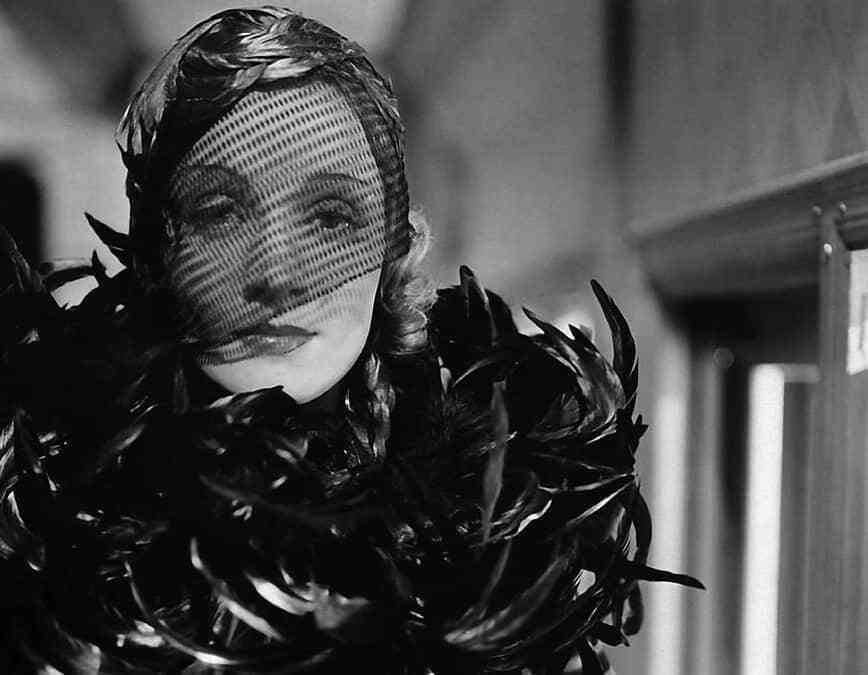Sternberg and Dietrich, Exiles on Santa Monica Boulevard

Written by Lars Nilsen, AFS Lead Programmer
Many film directors become closely identified with an actor — we might think of Scorsese and De Niro, or Hitchcock and James Stewart — these stars are their director’s avatars. Such connections just feel right and bring out the best in front of and behind the camera. It’s hard to imagine a more sublime partnership in this regard than the one shared by director Josef von Sternberg and star Marlene Dietrich.
The exhilaration that Sternberg clearly felt for Dietrich as a photographic subject is apparent in every ornately cluttered, multi-dimensional, half-occluded, veiled, and key-lit closeup. And its absence is sometimes just as keenly felt in scenes with her male co-stars, who tend to be as stolid and bloodless as Dietrich is alive with pent-up passion.
 It may seem to us today, watching these shockingly modern conceptions of character cavort with (usually) cardboard leading men, that the electricity in this pairing must have been clearly apparent to all who saw it, but that is not at all true. When Sternberg — having been lent to UFA, Paramount’s partner studio in Germany, for a prestige film starring the eminent actor Emil Jannings — attempted to cast the then-unknown Dietrich, he was met with almost unanimous resistance. In order to prove his point, he had a screen test made. Dietrich had no fight in her; she was resigned to losing the role, so she barely put any effort into the test. But this test, which so outraged his producers and his star, made Sternberg even more resolute. You can see why in the footage from that day (click here or on the image below to watch).
It may seem to us today, watching these shockingly modern conceptions of character cavort with (usually) cardboard leading men, that the electricity in this pairing must have been clearly apparent to all who saw it, but that is not at all true. When Sternberg — having been lent to UFA, Paramount’s partner studio in Germany, for a prestige film starring the eminent actor Emil Jannings — attempted to cast the then-unknown Dietrich, he was met with almost unanimous resistance. In order to prove his point, he had a screen test made. Dietrich had no fight in her; she was resigned to losing the role, so she barely put any effort into the test. But this test, which so outraged his producers and his star, made Sternberg even more resolute. You can see why in the footage from that day (click here or on the image below to watch).
The film was made with Dietrich, Sternberg overruled all the objectors, and, after it was released to much acclaim, all was forgiven. Sternberg returned to Hollywood a conquering hero with Dietrich in tow. Many felt their relationship was troubling. Sternberg’s rash personal style and Dietrich’s imperfect command of the language caused them to be seen in a Svengali/Trilby light by many, but the alchemy of director and star, while not always box office candy, was to prove irresistible for lovers of sneakily poetic Hollywood cinema.
When Sternberg photographed Dietrich, everything within the frame was a jewel setting for Dietrich’s arch and challenging luminosity. She smolders under acres of lace and pounds of feathers; her costumes sometimes required her to be driven to the set in the back of a truck to prevent any damage to the extravagant outfits. All of this is in the service of stories that are — if we’re being honest here — often less than compelling in and of themselves. In fact, it may be said that instead of the images serving the story, in these cases, the story serves the images — a conception that seems to us now very modern but at the time may have seemed merely bizarre. That is, if the audiences had not been sufficiently stunned by Dietrich’s closeups and fascinatingly insolent, frequently androgynous, manner. They were, and, by all evidence, they still are.
This divine pairing lasted for only six films and was, in fact, broken up by the studio; Dietrich famously bemoaned while being lit on her first non-Sternberg set, “Jo, why have you forsaken me?” From this very late vantage point, the penultimate film in the series, THE SCARLET EMPRESS, may be the most representative. It is certainly the most perverse. It is like the final salvo of the pre-code impulse, hurled at the censors and the Babbitts who would have seen the Hollywood dream factory converted to an efficiently running assembly line producing mediocre films for a mediocre people.
Andrew Sarris nails the appeal, and the historical importance, of THE SCARLET EMPRESS in his monograph for MOMA on Sternberg’s work:
From a contemporaneous vantage point, Bosley Crowther of The New York Times expressed similar sentiments in a less impressed light:
Hollywood is always dying and always being born. Today is no different than 1934 in that regard. Cinema’s revolutionary impulse is often clothed in feathers, androgyny, and frank horniness. Audiences are always stupefied, to use Sarris’ perfect adjective. In the Sternberg/Dietrich Hollywood pageants, we experience a perfect crystallization of what this meant in an earlier era.
ESSENTIAL CINEMA: DIETRICH/STERNBERG IN HOLLYWOOD
SHANGHAI EXPRESS (1932)
May 9 & 13
BLONDE VENUS (1932)
May 16 & 20
THE SCARLET EMPRESS (1934)
May 23 & 29
THE DEVIL IS A WOMAN (1935)
May 30 and June 3

















